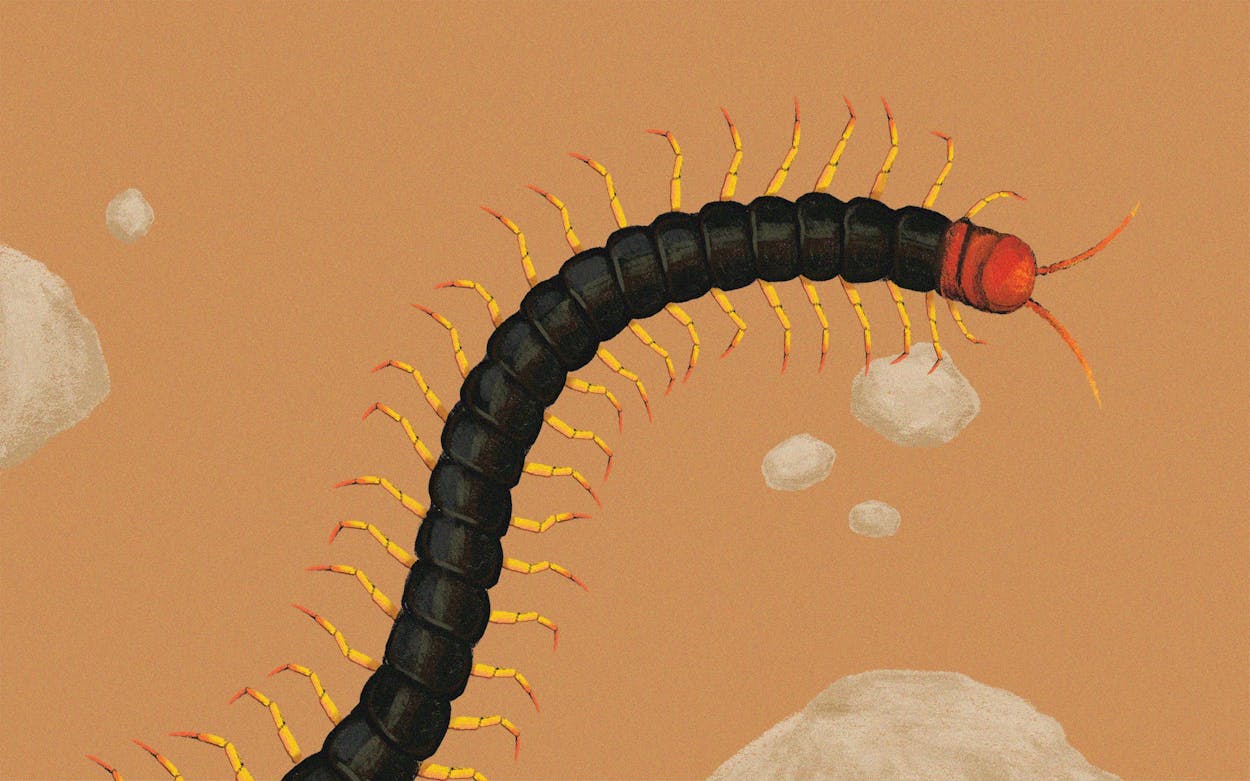Latin Name: Scolopendra heros
Size: As long as eight inches
Habitat: Statewide
When Jesse Pye first saw the giant centipede in bed with him, at a friend’s house in San Antonio two years ago, his brain refused to process it. “I thought it might be a stain on the comforter,” he recalls of the dark, golf ball–size object atop the duvet. He leaned in for a closer look, only to recoil as the golf ball unfurled into a seven-inch-long creature with a black body, a crimson head, and more than forty wriggling yellow legs. “Too many legs,” Pye thought. His pulse racing, he snapped some photos before wrapping the centipede in the comforter, like some burrito from hell, and shaking it free outside. The photos were picked up by news outlets around the world. Read on, if you dare, to meet North America’s biggest centipede.
This thing doesn’t live near me, does it?
It might! The Texas redheaded centipede is common across the state and much of the Southwest. It also thrives in parts of Arkansas, Kansas, Louisiana, and Missouri. But sightings don’t happen often, because it’s a nocturnal crawler. “During the day, they hide in sheltered areas,” such as under rocks or leaves, says Wizzie Brown, an entomologist with Texas A&M University’s AgriLife Extension Service. When encounters between humans and centipedes do happen, they tend to occur in the wee hours. Brown gets a lot of questions about the arthropod. “It’s never, ‘What is this?’ but ‘What the hell is this?’ ” she says.
Is it venomous?
Very. This predator will immobilize and devour pretty much any smaller invertebrate, as well as the occasional rodent or lizard. In 2016 a pair of hikers in Palo Duro Canyon, in the Panhandle, saw one feasting on a bat! Bites to humans are rare but quite painful, and while they’ve sent folks to the hospital, there are no known fatalities. Centipedes would much rather attack the bugs that annoy us, so they’re good to have around. (Though I don’t think I’ve convinced you.)
Don’t centipedes have a hundred legs?
That’s a myth. Centipedes have between 15 and 191 pairs of legs—always an odd number (no one knows why). This species has 21 or 23 pairs. And no, millipedes don’t have a thousand legs, either, except for one subterranean Australian species that boasts a whopping 1,306.
I’m still terrified. Does this species have any other redeeming qualities?
Its parenting skills are top-notch. The mothers are fiercely protective of their babies. “Once she lays a clutch of eggs, the mom will curl around them,” says Brown. “That’s probably to help keep them clean from mold, fungus, or anything that could damage the eggs.” Once they hatch, Mama stays close by until the li’l centipedes crawl off into the wide world. Their life span isn’t well-studied, but estimates range from five to ten years.
This article originally appeared in the February 2024 issue of Texas Monthly with the title “Texas Redheaded Centipede.” Subscribe today.
- More About:
- Critters









